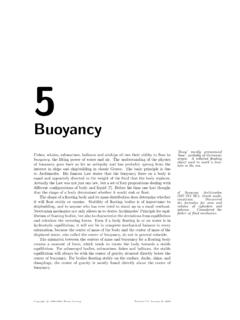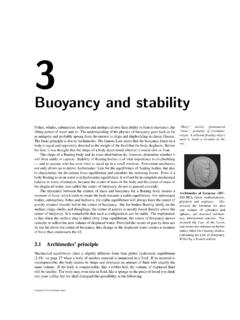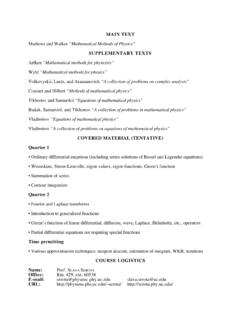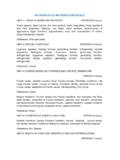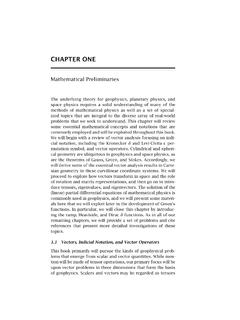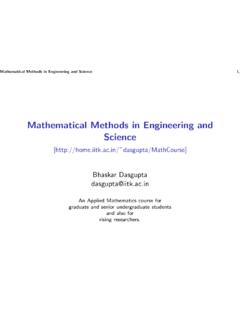Transcription of Georgia Tech PHYS 6124 Mathematical Methods …
1 Georgia tech phys 6124 Mathematical Methods of physics IInstructor: Predrag Cvitanovi cFall semester 2012 Homework Set #6due October 9, 2012== show all your work for maximum credit,== put labels, title, legends on any graphs== acknowledge study group member, if collective effort[All problems in this set are from Goldbart]Problem 1) Linear differential operatorsa) Consider the differential operatorL= ) Find a weight functionwso that the operator is self-adjoint, and findthe corresponding surface ) Consider separately the following boundary conditions for the func-tions on whichLacts:[ ]u(0) =u(2 ) =0,[ ]u(0) =u(2 ),[ ]u(0) =u (2 ) = each case, construct the adjoint boundary conditions and hence de-termine whether the given boundary conditions confer hermiticity which set(s) of boundary conditions would you anticipate thatLpos-sesses a complete set of orthogonal eigenfunctions?
2 In such cases, findthat complete set and exhibit the orthogonality ) Show that d/dxis the formal adjoint of the operatord/dxwith respectto the weight functionw=1. What is the form of the surface termQ?c) Consider the Sturm-Liouville operatorLdefined byLu= (pu ) that, providedpandqare real functions, the Sturm-Liouville oper-ator is self-adjoint. What is the form of the surface termQ?Problem 2) Sturm-Liouville formsBy constructing appropriate weight functions convert the following com-mon operators into Sturm-Liouville form:a)L= (1 x2)d2/dx2+ [( ) ( + +2)x]d/dx1b)L= (1 x2)d2/dx2 3x d/dxc)L=d2/dx2 2x(1 x2) 1d/dx m2(1 x2) 1 Problem 4) Properties of hermitian matricesThe complex conjugate of a matrixMis the matrixM whose elements aregiven by(M )jk=(Mjk).
3 The transposeMis the matrixMTwhose ele-ments are given by(MT)jk=Mkj. The hermitian conjugate ofMis the matrixM defined to be(MT) or equivalently(M )Twhose elements are given by(M )jk=(Mkj) .Mis said to be hermitian if it equals its own hermitianconjugate, ,M =M. Its matrix elements satisfy(M )jk (Mkj) = the hermitian ) Prove that the eigenvalues ofMare ) Prove that the eigenvectors ofMhaving non-degenerate eigenvalues ) Prove that ifuandvare degenerate eigenvectors ofMthen u+ v(inwhich and may be complex) is also a degenerate eigenvector. Henceshow that degenerate eigenvectors may be chosen to be problemsProblem 3) Difference equationsThe purpose of this question is to introduce you to some of the propertiesof certain difference (rather than differential) equations.
4 We shall, for the sakeof simplicity, primarily focus here on the linear first-order ) Solve the difference equation:an+1=an+qn, where{qn} n= ) Solve the difference equation:an+1=pnan, where{pn} n= ) By introducing asumming factor, the analogue of an integrating factor,solve the general first-order linear inhomogeneous difference equation:an+1=pnan+qn, where{pn} n=1,{qn} n=1anda1are ) Solve the difference equation:an+1=n an/(n+1) +n, in terms ) Solve the nonlinear difference equation:an+1=a2n, in terms ) The discrete derivativeDanof a discrete functionanis defined to beDan an+1 an. Compute the second and third discrete derivativesofan, namelyD2an[ D(Dan)] andD3an[ D(D(Dan))].
5 G) The discrete antiderivativebnof a discrete functionanis defined to bebn nj=n0aj. The integer function that corresponds to the continuousfunctionf(x) =xkis the discrete functionfn=n(n+1) (n+k 1),also havingkfactors. CalculateD ) By taking the logarithm, solve the nonlinear difference equation:an+2=a2n+1 ) By noting that the transcendental functions cosxand coshxsatisfy thefunctional equationf(2x) =2f(x)2 1, solve the nonlinear differenceequation:an+1=2a2n 1 for the two cases,|a1|>1 and|a1|< ) Solve the difference equation with constant coefficients:an+2+3an+1+2an= ) By introducing the generating functionf(x) = n=0anxn, solve the con-volution difference equation:an+1=K nj=0ajan j, witha0=1.
6 [Hint: Find and solve an equation forf(x); expand the solution in a Tay-lor series; identifyanfrom the coefficients.]3 Problem 5) One-dimensional motion of the quartic oscillatorConsider a particle of massmmoving in the quartic potentialV(x) = (g/4) ) In terms of the Jacobian elliptic function cn(u,k), find the trajectory of theparticle as a function of time, given the initial positionx0and the energyE. [Hint: you may use the result that the Jacobian elliptic function cn(u,k)satisfies the nonlinear ordinary differential equation(dcn/du)2=(1 cn2)(k 2+k2cn2), in whichk2+k 2=1; see, , Gradshteyn and Ryzhik,Table of Integrals, Series and Products, ) Sketch cn(u,k)as a function ofufork2=1/2.]
7 Note the qualitative simi-larity with the familiar cosine function. (This similarity becomes an iden-tity whenk=0.)[Hint: See, , Abramowitz and Stegun,Handbook of MathematicalFunctions, 16, fig. 1; note that this handbook uses the notationm k2.]c) Determine the period of the motion in terms ofEand the complete ellipticintegral of the first kindK(k).[Hint: See, , Abramowitz and Stegun, and fig. 1.]Problem 9) Lyapunov equationConsider the following system of ordinary differential equations,ddtQ(t) =A(t)Q(t) +Q(t)AT(t) + (t),in whichQ,Aand are [N N] matrix functions oft, withAand known,andQsought. The superscript T indicates the transpose of the matrix.
8 Findthe solutionQ(t), subject to the boundary conditionQ(t0) =Q0, by taking thefollowing steps:i) Write the solution in the formQ(t) =J(t)Q0JT(t) +J(t)W(t)JT(t), withJ(t)satisfyingddtJ(t) =A(t)J(t),subject to the initial conditionJ(t0) =I, in whichIis the [N N] ) Show thatW(t)then satisfiesddtW(t) =J 1(t) (t)(JT(t)) 1, subject tothe initial conditionW(t0) = ) Integrate the preceding equation to obtainQ(t) =J(t)Q0JT(t) + tt0d J(t)J 1( ) ( )(JT( )) 1JT(t),in terms of (the as yet unknown) matrixJ(t).iv)J(t)can be determined, usually by numerical integration, asJ(t) = Texp{ tt0d A( )},where Tdenotes the time-ordering ) Show that ifA( )commutes with itself throughout the intervalt0 t(never happens in real life) then the time-ordering operation is re-dundant, and we have the explicit solutionJ(t,t0) =exp{ tt0d A( )}.
9 Show that, in this case, the complete solution reduces toQ(t) =J(t)Q0JT(t) + tt0dt J(t,t ) (t )J(t,t )

